On this date in 1924, the Boston Bruins officially received their NHL franchise, which made them the first club in the league located in the United States and, with the addition of the Montreal Maroons, brought the NHL up to six member clubs.
Charles Adams was taken by professional hockey after having attended the 1924 Stanley Cup Finals between the NHL's Montreal Canadiens and the Calgary Tigers of the WCHL.
His first order of business was to hire Art Ross as his new club's general manager, a post he would remain in for 30 years. It was Ross who coined the name "Bruins" after being challenged by Adams to come up with a name for the franchise of an animal that would represent speed, agility and cunning, while the club's original colors of brown and gold were taken from Adams grocery store chain, First National Stores.
The Bruins played their first game on December 1, 1924 against their fellow expansion brothers that season, the Maroons, with the Bruins prevailing 2-1. The opening night victory flattered to deceive, as the Bruins would win just five more games that season on their way to a last place finish and a 6-24-0 record.
The inaugural 1924-25 Boston Bruins
Jimmy Herberts led the team in scoring by a wide margin, with is 17 goals in 30 games accounting for 35% of the Bruins 49 goals that season. His 22 points far outdistanced the next player who managed a paltry 8!
The Bruins first leading scorer Jimmy Herberts
The Bruins began life in the Boston Arena for the first four years of their existence prior to moving into their long time home, the Boston Garden, while the Boston Arena would become the property of Northeastern University and, while renamed the Matthews Arena in 1982, it remains the oldest surviving indoor ice arena still in use in the world. While the Bruins moved out in 1928, professional hockey would return in 1972 with the arrival of the New England Whalers of the upstart World Hockey Association for games during their inaugural season prior to moving to Hartford, Connecticut.
The Bruins improved during their second season of 1925-26 in the now seven team NHL, but still finished outside the playoffs by but a single point despite their winning record of 17-15-4. Carson Cooper, with 28 goals, and Herberts, with 26, tied for the team scoring lead of 31 points.
1925-26 Boston Bruins
In 1926-27, the NHL divided itself into two divisions, with the Bruins in the new "American" division, with their success having opened the floodgates of the United States market with teams now in New York, with both the Rangers and Americans, Chicago, Pittsburgh and Detroit. The Bruins came second in the division behind the Rangers with a 21-20-3 record, led by Harry Oliver's 18 goals and 24 points. A new arrival to the Bruins roster would come in the from of the legendary Eddie Shore, a rough and tough future Hall of Famer who would play for the club until 1940.
1926-27 Boston Bruins
In the playoffs for the first time, the Bruins would defeat the Chicago Black Hawks 6-1 and 4-4 to win their two-game, total-goal series 10-5. Playing the same format, they would eliminate the Rangers after a scoreless tie in Boston with a 3-1 win on the road in New York to advance to the Stanley Cup Finals, the first contested by two NHL clubs.
The finals were a best-of-five versus the Ottawa Senators, however the first game was played to a scoreless tie. Ottawa won 3-1 before another tie, this time 1-1. Ottawa wrapped up the championship with another 3-1 win, taking the best-of-five by the unusual margin of 2-0-2.
The Bruins captured their first division title in 1927-28 with 20 wins, 13 losses and 11 ties as Oliver again led the club in scoring with 18 points, one more than defenseman Shore's 17. Another legendary Bruin Dit Clapper would join the club that season and remain with the Bruins for 20 years. The Rangers got their revenge and knocked the Bruins out of the playoffs with a 1-1 draw and a 4-1 win in Boston.
The Bruins again won the American Division in 1928-29 with a 26-13-5 record which included going undefeated for all of January (11-0-2). Oliver remained in his familiar place atop the scoring table with 17 goals and 23 points in 43 games.
Their division title earned them a first round bye in the playoffs. Tiny Thompson in goal shut out the Montreal Canadiens 1-0 and again 1-0 in the first two games and the Bruins closed out the series with a 3-2 win.
Awaiting them in the finals were the Rangers, and the Bruins dispatched them with a 2-0 win at home followed by a 2-1 win in New York to win the first Stanley Cup in franchise history as they became the last team until 1952 to sweep all their playoff games.
The Stanley Cup Champion 1928-29 Boston Bruins
The Bruins would return to the finals the following season but come up short. They would win Stanley Cups again in 1939 and 1941, but then suffer a drought which would last 29 years, including a dismal run where they would miss the playoffs eight consecutive seasons beginning in 1960 and finish last six out of seven seasons from 1961 to 1967, making their championship just three seasons later in 1970 all the more remarkable.
Today's featured jersey is a 1924-25 Boston Bruins George Redding jersey from the Bruins very first season. This jersey style was used for only one season and sold at auction for $27,000 in April, 2009. It is believed to be the only surviving jersey from the Bruins inaugural season, making it a truly unique item and an incredibly significant piece of memorabilia from such a historic franchise and one of the most exciting jerseys we have ever featured here at Third String Goalie.
Redding, a defenseman, would play 35 games for the Bruins over their first two seasons, scoring 3 goals and 2 assists, all in 1924-25, and would play six more seasons of hockey in lower leagues, making stops in Boston, London, Ontario, Minneapolis and Buffalo.
This jersey is the basis for the jersey that the Bruins will be wearing in the 2016 NHL Winter Classic, which they will host at Gillette Stadium, with the jersey updated to the Bruins current colors of black and gold rather than the Bruins original brown and gold.
Our video section today is a look back at the history of the Boston Bruins franchise.

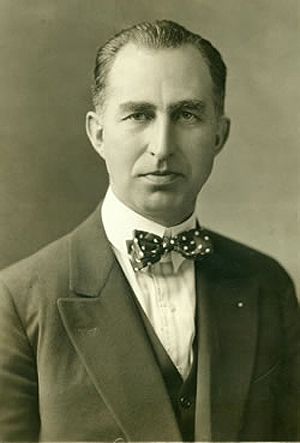

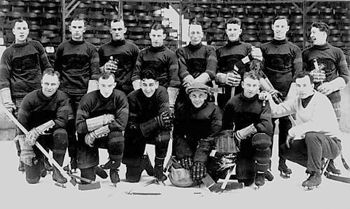


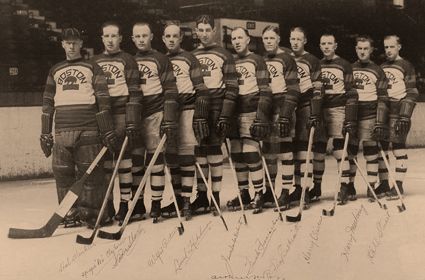

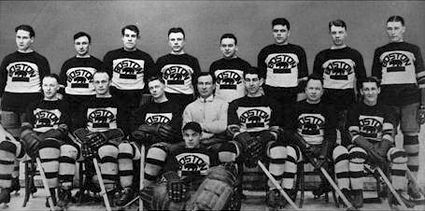

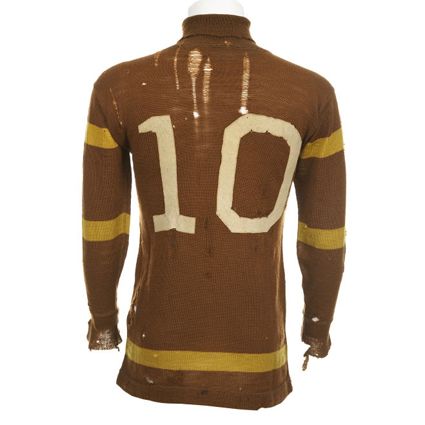










No comments:
Post a Comment
We welcome and encourage genuine comments and corrections from our readers. Please no spam. It will not be approved and never seen.